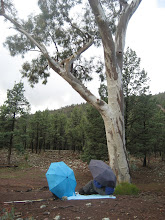The towering cliffs of Alligator Gorge and the emotional encounter with our first feral emu were left far behind, as we continued down the sandy creek bottom of Mambray Creek in Mt. Remarkable National Park. It was still early in the season, the longest day of the year several weeks away, but the hot sun beat down on us as we crossed the desolate landscape. Anxious to arrive at the Hidden Gorge turn-off, Mark had left me several hundred meters behind. I had just entered one of the few native pine forests in the canyon, when out of the corner of my eye I caught some movement. I quickly froze and I could hear something scurrying up the tall tree. I wondered if it could be a squirrel, even though I had yet to see one in Australia. I couldn't think of any other animal that would be climbing a tree, and the truth be known I was relieved that it wasn't another emu--I had had my fill earlier in the morning. I cautiously left the path and began to walk, in a very large circle, around the tree. I wanted a better view of who or what was there. As I peeked around the trunk, I couldn't believe my eyes. I reached for my beloved camera, but realized that Mark was carrying it. I returned to the main path and in a low voice I called to Mark to quickly bring the camera. Since I wasn't shrieking hysterically, he wanted to know what had piqued my interest enough for a photo. When I informed him a I had to get a photo of a lizard he laughed and said that wasn't worth walking back for. I assured him that this was not one of the tiny copper guys that we had seen earlier and that he really needed to return. I think we both were in a bit of shock as we stood at the base of the tree looking at the meter long lizard hugging the tree in front of us. I couldn't help but wonder if all Australian reptiles, especially snakes, were on steroids.
It turns out that we were looking at a lace monitor, or tree goanna, which is one of the largest lizards in the world. It is not Australia's largest lizard--that title goes to the Perentie--but they can grow to be about 2 meters in length and weigh up to 20 kilos. They have powerful limbs and strong curved claws which make them versatile and they are able to run, swim and climb trees. These carnivores can be found throughout eastern and into southeastern Australia in wooded habitats. They are most active from September to May, and the females lay eggs in termite mounds.
We have since seen several of these grey with cream spotted lace monitors, but always in the same National Park. However, we haven't done much hiking in the eastern part of the country. So when hiking in the eastern/southeastern part of Australia keep your eyes open and, in the trees, you may come across one of these monster lizards.
sunday song – christmas in hollis
1 day ago








Hi from Scotland Maya! Yikes, that is one big lizzard. And his color seems to match the trees so well too. It was so interesting learning how strong they are...
ReplyDeleteThanks for sharing your hiking experience encountering one of the world's largest lizzard.
Have a good day.
Hi Kathy, thanks for taking the time to stop in all the way from Scotland!! My lizard friend did blend in well with the tree. If I hadn't seen/heard him move I might have missed him.
ReplyDelete